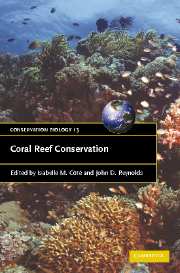Book contents
- Frontmatter
- Contents
- List of contributors
- Foreword
- Preface
- Part I Setting the stage
- 1 Status of coral reefs of the world: summary of threats and remedial action
- 2 Death and resurrection of Caribbean coral reefs: a palaeoecological perspective
- 3 A seascape-level perspective of coral reef ecosystems
- 4 Cold-water coral reefs: status and conservation
- Part II Uses and abuses: ecological and socio-economic issues
- Part III The way forward: tools and approache
- Index
- Plate section
- References
1 - Status of coral reefs of the world: summary of threats and remedial action
Published online by Cambridge University Press: 05 June 2012
- Frontmatter
- Contents
- List of contributors
- Foreword
- Preface
- Part I Setting the stage
- 1 Status of coral reefs of the world: summary of threats and remedial action
- 2 Death and resurrection of Caribbean coral reefs: a palaeoecological perspective
- 3 A seascape-level perspective of coral reef ecosystems
- 4 Cold-water coral reefs: status and conservation
- Part II Uses and abuses: ecological and socio-economic issues
- Part III The way forward: tools and approache
- Index
- Plate section
- References
Summary
INTRODUCTION
While the history of active coral reef research stretches back over 100 years, the concern for the declining status of coral reefs is relatively recent, probably less than 25 years. The first major attempt to alert the global coral reef science community to the threats posed to coral reefs was in 1981 by Edgardo Gomez, who subtitled the 4th International Coral Reef Symposium in Manila, May 1981, as The Reef and Man (Gomez, 1982). Similarly Bernard Salvat and David Stoddart raised the alarm in 1982 (Salvat, 1980, 1982; Stoddart, 1982). At this time, most coral reef researchers worked from field stations during vacations; field stations specifically chosen that were adjacent to healthy and flourishing coral reefs seemingly not affected by human impacts. There was a small group of coral reef scientists who were working in developing countries, however, who were aware of an impending crisis for coral reefs.
Since that 1981 Symposium, there has been a steady increase in the involvement of coral reef scientists in the applied aspects of coral reef management (summarized in Knowlton, this volume). A paper published by Don Kinsey in 1988succinctly summarized the stresses to coral reefs (Kinsey, 1988). Similarly there were other reports of localized damage to coral reefs by coral reef scientists (Brown, 1987; Gomez, 1988; Pauly and Chua, 1988; Grigg and Dollar, 1990), but it was not until 1992 that global attention was alerted to the threats facing coral reefs.
- Type
- Chapter
- Information
- Coral Reef Conservation , pp. 3 - 39Publisher: Cambridge University PressPrint publication year: 2006
References
- 22
- Cited by



